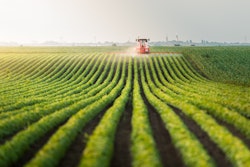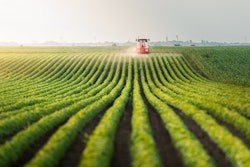
Food and beverage companies are at the forefront of a transformative journey toward sustainable agriculture as global concerns about environmental impact intensify. The agriculture industry accounts for roughly 10% of greenhouse gas emissions in the United States alone, and sequesters 12.5 gigatons of carbon dioxide globally each year. To improve agriculture’s environmental impact and make progress on the world’s environmental, social, governance (ESG) initiatives, industry leaders must stop thinking of sustainable agriculture as merely a buzzword and start fundamentally recalibrating current industry practices.
For example, farmers frequently apply agricultural fertilizers to soils which substantially contribute to nitrous oxide (N₂O) emissions. Mitigating these emissions entails a reduction in the fertilizer quantities applied and a strategic avoidance of application during conditions conducive to N₂O formation, such as heightened soil moisture, elevated nitrogen availability, and warmer temperatures. Additionally, the heightened decomposition of plant matter in soils has a high carbon emissions count. This can be addressed by implementing cover cropping, a practice involving the deliberate cultivation of specific crops during periods when the primary cash crop is not in season. Cover cropping serves to shield the soil and regulate the decomposition process.
But these strategies are only the beginning. Many companies are just starting to adopt more sustainable agricultural practices to address their greenhouse gas emissions; however, further recognition of agriculture’s impact on the environment and expanded regulation, such as the EU deforestation regulation, will drive more change ahead.
How to ensure success in the sustainable agriculture transition
Leading food and beverage companies are translating words into action, understanding tangible change requires concrete steps. These steps incorporate the following key elements, ensuring a more successful transition to sustainable agricultural practices.
Build transparent supply chains. Transparent and traceable supply chains are the cornerstone of sustainable food and beverage operations. Understanding the origins of agricultural raw materials and the farming methods they undergo is paramount for substantiating sustainability claims. Enhanced transparency not only upholds the integrity of these claims but also equips consumers with the knowledge to make conscientious choices. As technology and data analysis advance, they emerge as instrumental tools for achieving this transparency. From meticulously tracing the origins of ingredients to ensuring fair labor practices, leveraging technology becomes a catalyst for building trust and aligning with the expectations of an increasingly discerning consumer base.
Implement a phased strategy. Acknowledging the considerable challenges faced by farmers, often grappling with thin profit margins, leaders in the food and beverage industry are strategically shaping their sustainability initiatives in incremental phases. Farmers will not replace their time-honored agricultural practices and traditions on a whim with unproven methods that have no guarantee of comparable crop yields or revenue. So, rather than opting for radical overhauls, leading companies should prioritize gradual changes as the foundational approach, measuring and quantifying improvements as they come, and engage with farmers in the process. This method ensures not only economic viability for farmers but also establishes sustainability as an enduring, long-term commitment.
Effectively transitioning to sustainable agriculture demands a comprehensive change management strategy. Top-down mandates prove insufficient. Instead, a collaborative and partnership-driven effort is essential. Such an approach involves stakeholders at every level of the supply chain, fostering a collective commitment to sustainable practices and ensuring the success of incremental changes over time.
Adopt technology. Technology stands as a powerful ally in the pursuit of sustainable agriculture. Today's food and beverage leaders are moving away from common tools and techniques, such as traditional farming methods and outdated equipment, and investing in cutting-edge tools and innovations, such as IoT-enabled solutions and data-driven technologies, to streamline and enhance farming practices.
European and North American farmers lead global agricultural technology (AgTech) adoption, with about 61% currently using or planning to adopt one AgTech product in the next two years. Leveraging digital data and analytics allows for optimized resource use while maximizing yield. Remote sensing tools and analytics provide real-time insights into soil health, water usage, and crop conditions, empowering farmers to make informed decisions.
For example, the International Finance Corporation (IFC), a part of the World Bank Group, recently invested in digitizing coffee, pepper, and corn supply chains in Vietnam in collaboration with global buyers. Today, over 2,000 small farmers use mobile apps to access valuable agronomic advice – helping them improve the quality and quantity of their crops, while also reducing their use of harmful chemicals and pollutants. In addition, these apps allow their partners, leading food and beverage companies, to gain more oversight of their suppliers’ farming practices and product quality.
Measure for success. Food and beverage leaders understand that what gets measured gets managed. Robust metrics and key performance indicators (KPIs) are being established to track and evaluate the progress of sustainable practices to not only provide companies with insights into the effectiveness of their initiatives but also allow farmers to witness the tangible impact of their sustainable efforts.
These metrics extend beyond traditional measures of productivity and yield to encompass a range of sustainability indicators. From water and energy usage to greenhouse gas emissions, soil health, and biodiversity conservation, these metrics provide a comprehensive snapshot of the ecological footprint of agricultural operations.
Continuously monitoring these KPIs ensures that the adopted practices are also economically viable. It allows companies to identify areas of success and areas that require further attention, facilitating an adaptive and responsive approach to sustainability.
Incentivize sustainable practices and empower farmers. Food and beverage leaders understand that incentivizing sustainable practices goes beyond basic compliance. Fair pricing structures, financial support for adopting sustainable methods, and long-term partnerships contribute to creating a conducive environment for farmers. By offering economic incentives, these companies actively encourage farmers to embrace environmentally friendly practices, ensuring a harmonious relationship between economic viability and ecological responsibility.
Equipping farmers for success ensures they are empowered with the tools, resources, and knowledge they need to achieve sustainable agriculture. Food and beverage leaders must invest in the alignment of interests and collaboration with farmers. Training programs, workshops, and partnerships with agricultural experts empower farmers with the skills needed to navigate the complexities of sustainable practices. In addition, the adoption of KPIs is a powerful tool to encourage farmers by either identifying high performers and rewarding them accordingly or providing additional support to underperformers. This collaborative approach not only enhances the effectiveness of the transition but also fosters a sense of shared responsibility for the future of agriculture.
Raising consumer awareness. To facilitate informed choices, food and beverage companies should actively pursue and promote certifications that verify the sustainability of their products. By engaging directly with the farmers, the companies can collect valuable data on sustainable practices. The information gathered becomes the foundation for certifications, such as “Rain Forest Alliance” or “Organic.” These certifications serve as tangible indicators for consumers, signaling that the product aligns with established environmental standards. With easily accessible and understandable official information on packaging, consumers seeking to support sustainable practices can more easily make informed decisions.
Today's food and beverage leaders are not merely responding to external pressures for sustainability; they are actively pioneering a future where economic viability works hand in hand with environmental responsibility. By taking practical steps, these companies are laying the groundwork for a sustainable agricultural ecosystem. In doing so, they not only secure their place as industry leaders but also contribute to a resilient and environmentally conscious future for food production.


















